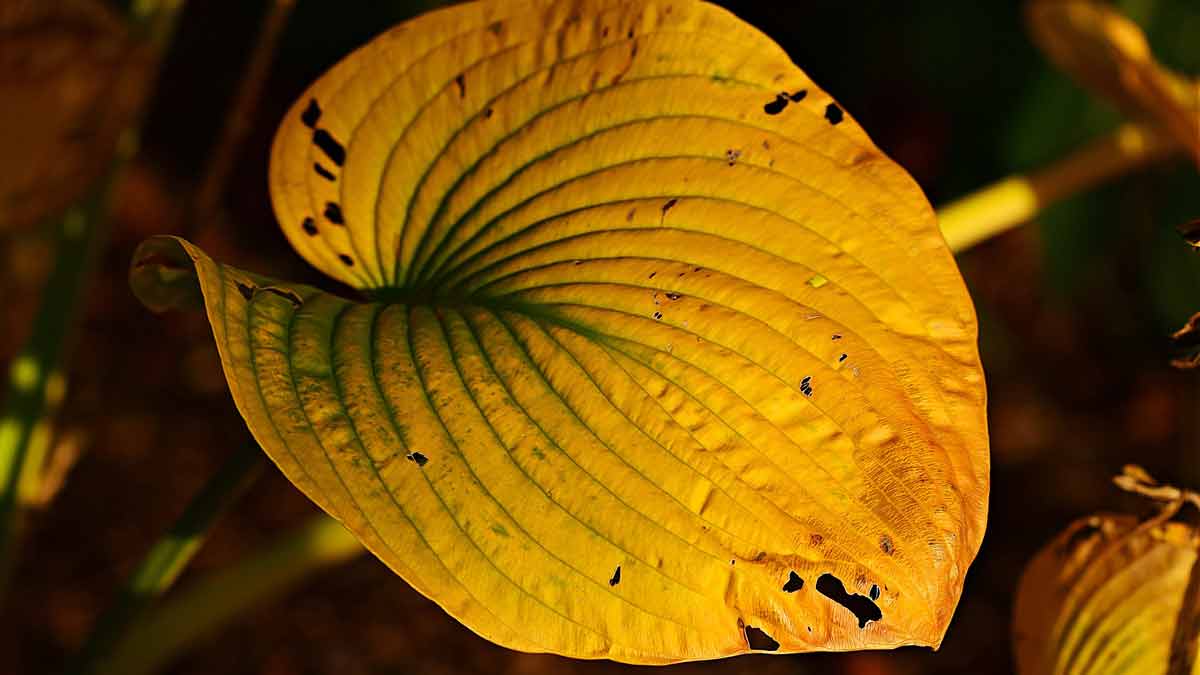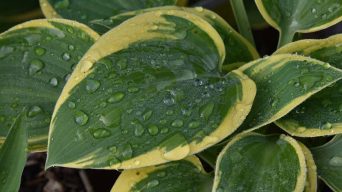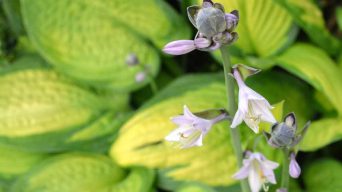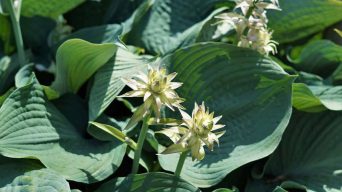Hosta plants are a popular choice for gardeners who want to add color and texture to their backyard oasis. They are easy to maintain, require minimal care, and are known for their beautiful, lush foliage.
Unfortunately, when left under the hot sun for too long, hostas can develop scorch, which is a condition that causes the leaves to turn yellow or brown in spots and become dried out.
Fortunately, there are several ways to fix hosta scorch and restore the vibrant foliage of your plants.
What Causes Hosta Scorch?
Several factors can cause a hosta scorch, including too much direct sunlight and extremely hot weather. Additionally, overly dry soil or poor drainage can contribute to the problem.
The most common causes of hosta scorch are:
Too Much Sunlight
Hostas are not typically sun-loving plants and can suffer from too much direct sunlight.
The hosta leaves will become discolored and scorched when exposed to too much sunlight.
The resulting damage is tissue death where direct sun exposure has occurred. The injury may be white or brown, and the leaves may become dry or brittle.
Hostas are shade-loving plants that must be shielded from the sun’s rays. If they are planted in a sunny area, move them or provide shade with an awning or umbrella.
Hostas thrive in any part of the garden that receives at least three to four hours of dappled sunlight a day.
Heatwave
A heatwave is a prolonged period of abnormally high temperatures. It can cause plants to experience stress as their roots cannot absorb enough water from the soil due to lack of rainfall or frequent watering.
In addition, prolonged exposure to high temperatures can cause plant tissues such as leaves and fruit to desiccate, resulting in scorched or sunscalded foliage that may appear brownish-black and dry.
Heatwaves can lead to a hosta scorch by increasing the air’s humidity level, which causes leaf surfaces not able to dry quickly enough.
Also, heat waves increase air circulation around plants, increasing wind speed and disrupting moisture levels in the air around them.
This combination of increased humidity and wind speed can lead to more frequent occurrences of leaf scorch in gardens during heatwave events.
Lack of Water
Lack of water can cause hosta scorch because it prevents the plant from absorbing enough nutrients and water. The leaves become weakened, discolored, and eventually die off.
The effect of this is that the hosta leaves will become brown or scorched looking as they try to compensate for their lack of nutrients and water. If left untreated for too long, this can also lead to other problems, such as root rot.
To prevent a hosta leaf scorch, it is essential to maintain a consistent watering schedule. Water plants deeply and often enough that the soil stays moist but not soggy.
It’s also important to mulch around the base of your hosta plants to help keep the soil cool and retain moisture. This will help prevent water shortages during times of drought or heat waves.
Insects and Pests
Insects and pests that cause hosta scorch include aphids, slugs, snails, caterpillars, mites, scale insects, and mealybugs. These pests feed on the edges of the foliage, leaving them ragged and brown. They can also cause irregular holes in the center of the hosta plant leaves.
Additionally, aphids produce a sticky substance called honeydew which can lead to fungal growth on the plant’s surface. This can further damage hostas or other plants close to it.
To keep pests and insects from damaging your hostas, regularly inspect them for signs of infestation. If you find any, immediately treat the plant with an insecticide or other pest control methods.
Fungal Infections
Fungal infections associated with hosta scorch include anthracnose, leaf blight, and leaf spot. Anthracnose is a fungus that causes circular spots with a dark border around them.
Leaf blight causes browning or yellowing of hosta leaves, while leaf spot results in small spots on the leaves.
Both diseases can be prevented by treating your hostas with copper fungicide or other appropriate fungicides. Also, avoid over-watering your hostas to prevent a fungal disease from occurring in the first place.
In addition, make sure not to overcrowd plants, as this can increase their susceptibility to fungal diseases.
Heavy Mulching
Mulching can cause hosta leaves to scorch if it is too heavy or applied incorrectly. This is because mulch acts as an insulator, preventing the soil from cooling down in the summer and keeping it warm in the winter.
The result of this is that the roots of hostas will not be able to absorb enough moisture, leading to scorched leaves and potentially even death of the plant if left untreated.
Poor Soil Quality
Poor soil quality can cause hosta scorch due to its inability to absorb and retain enough moisture. This causes the plant to dehydrate, resulting in scorch marks on the leaves.
The effects of poor soil quality are visible in the form of browning, curling, and even death of the hosta plants if left untreated. To prevent this, it is important to ensure that the soil around your hostas is of good quality.
This can be done by adding organic material such as compost or manure and ensuring that the soil’s pH level is between 6.5 and 7.5. Additionally, adding a layer of mulch around your hostas is important to keep the soil cool and moist.
What Are the Symptoms of Hosta Scorch?
Knowing the signs and symptoms of hosta scorch can help you identify it quickly and take the necessary steps to prevent further damage.
Common symptoms of hosta scorch include:
Yellow or Brown Leaf Edges
Hosta leaves will typically show yellow or brown edges when they’ve been affected by scorch. This discoloration usually starts from the tips of the leaves and moves inward toward the leaf veins.
A dry, brittle texture can also accompany the discoloration.
Brown Spots on Leaves
Another symptom of a hosta scorch is brown spots or patches on the leaves. These can range in size and shape, but they are mostly circular and have a dark border around them.
Leaf Tips That Appear Burned, Dried Out, and Brittle
The tips of the hosta leaves can also appear burned, dried out, and brittle. This is usually caused by intense heat or dehydration from a lack of moisture.
An excellent way to check is by gently squeezing the leaves; if they feel dry and brittle, it’s a good indication of scorch.
Dark Spots on the Outer Leaves
If the hosta leaves are affected severely by scorch, they may start to show dark spots on the outer edges. These spots are usually darker than the rest of the leaf and may have a red or orange hue.
Wilting or Drooping of the Entire Plant
If the hosta is affected severely by scorch, it may start to wilt or droop. This can be an indication of dehydration and a sign that the plant needs more water.
Other factors can also cause wilting or drooping leaves, so it’s important to check for all the other signs and symptoms of hosta scorch before taking further action.
Leaf Curling
Hostas leaf curling can be another symptom of scorch. This happens when the leaves start to curl inward, usually starting from the tips of the leaves and moving downward.
This can be caused by excessive heat, dehydration, or even a lack of adequate nutrients.
How To Fix Hosta Scorch
If you’ve identified hosta scorch, there are several steps you can take to help the plant recover.
1. Provide Adequate Water
The first step to treating the hosta scorch is ensuring the plant receives enough water. The soil should be kept moist but not soggy. If the soil drys out too quickly, it may be necessary to amend it with compost or manure.
Hostas should be watered at least once a week and more often during hotter months.
2. Move the Plant to an Area with Partial Shade
Another way to help treat leaf scorch is to move the plant to an area with partial shade. This will help protect it from intense heat and direct sunlight, which can cause further damage.
Hostas need indirect sunlight to thrive, so finding the right balance between sun and shade is essential.
3. Prune Off Damaged Leaves
Pruning off any damaged leaves can help encourage new growth and help the plant recover from scorching. The affected leaves should be trimmed as close to the base of the leaf as possible.
Cutting off dead and damaged leaves also helps the plant focus its energy on healthy growth.
4. Amend the Soil and Add Mulch
Mulching can help reduce the effects of leaf scorch in hostas. It keeps the soil moist, which prevents it from drying out quickly and helps to minimize heat exposure.
As a result, mulching can reduce the likelihood of leaf scorch in hostas by protecting them from excessive heat and moisture loss. It also helps to prevent weeds from growing by blocking their access to sunlight.
5. Avoid Excess Sunlight
Excess sunlight can cause hosta leaf scorch, also known as sunscald, in plants. This occurs when the plant is exposed to high temperatures and intense sunlight for prolonged periods.
Excess sunlight can damage the leaves of plants, causing them to become bleached and white.
The outer tissue may also become soft and wrinkled, leading to secondary decay. If left untreated, this damage could worsen over time or lead to an infection or disease in the fruit itself.
Tips on How To Prevent Your Hostas From Getting Scorched Again
Prevention is the best way to protect hostas from scorching. Here are a few tips to help you prevent leaf scorch in your plants:
1. Plant Hostas in an Area With Plenty of Shade
Planting hostas in an area with plenty of shade can prevent scorching. Hostas are shade-loving plants, but too much sunlight causes leaves to scorch and bleach out.
By planting hostas in an area with plenty of shade, you can ensure they receive the right amount of sunlight for optimal growth without risking scorching. Keeping the soil moist will also help prevent dry conditions that could lead to scorching.
2. Install Shade Cloth or Other Coverings
Installing shade cloth or other coverings can help protect hostas from scorching. This prevents excessive sunlight from reaching the plants and keeps them cool in hot weather.
Shade cloth is also a great way to prevent weeds from growing around your hostas, as it blocks out sunlight and prevents them from taking root.
3. Use Mulch to Retain Moisture
Adding a layer of mulch around hostas can help prevent them from getting scorched by the sun. It helps to retain moisture and prevents weeds from emerging.
By adding a layer of mulch around hostas, you can reduce the risk that they will get scorched by the sun again next year. It also helps to keep their roots moist and discourages weeds from growing around them.
4. Keep an Eye on the Weather
When it comes to preventing hosta scorch, one of the best things you can do is keep an eye on the weather. If there are days when temperatures are extreme or prolonged exposure to sunlight is expected, consider taking extra precautions such as providing shade cloth or adding mulch.
This can help reduce the risk that your hostas will get scorched again and allow them to thrive in the garden.
5. Apply Fertilizer Regularly
Fertilizing hostas regularly can help reduce the risk of scorching. Applying fertilizer helps feed the plants and keeps their foliage healthy, which can help increase their resistance to extreme heat and sunlight.
Applying fertilizer regularly ensures that your hostas get the nutrients they need to stay healthy and strong in the face of intense temperatures and sunlight. This can help reduce their risk of scorching and keep them looking beautiful in the garden.
6. Water Regularly and Soak Deeply
Keeping your hostas well-watered is essential for preventing scorching. Watering deeply and regularly helps keep the soil moist and prevents it from becoming too dry, making the plants more susceptible to damage from excessive sunlight.
Soak the soil around your hostas deeply each time you water them, and do so evenly to ensure that all parts of the plant receive adequate moisture. This can help keep your hostas healthy and reduce their risk of scorching.
7. Prune Dead or Damaged Leaves
Dead leaves can provide a home for pests, damaging your hostas if left unchecked. Pruning off dead and damaged leaves regularly can help keep your plants healthy and reduce the risk of scorching.
Additionally, pruning helps stimulate new growth, benefiting your plants in more ways than one.
Following these tips can help you prevent hosta scorch and keep your plants looking their best. With the proper care and extra precautions, you can ensure that your hostas thrive in the garden year after year.
Should You Cut off Burnt Hosta Leaves?
When it comes to fixing hosta leaves scorching, the first thing you’ll need to decide is whether or not it’s necessary to cut off any of the burnt leaves.
Generally speaking, cutting away parts of a plant damaged by environmental factors (such as scorching temperatures) can be beneficial in helping it recover. This is because cutting away dead or dying leaves allows more energy to be directed toward the healthier areas of the plant.
However, while cutting off scorched hosta leaves in some cases can be beneficial, it’s essential to do so correctly, as taking too much of the foliage away can seriously impede a plant’s recovery process.
If you’re uncertain how much to cut away, it’s usually best to err on caution and leave as much foliage intact as possible.
When making cuts, you should use sharp, sterile pruning shears and take special care not to damage or tear any healthy leaves surrounding the burnt ones. After removing any damaged leaf, you should also make sure to properly dispose of them, as they can be a source of disease for other plants.
Can Hostas Recover From Sun Damage?
Hostas can recover from sun damage, but it depends on the severity of the damage. If only a few leaves are scorched, they may be able to recover with proper care.
However, if all the leaves have been damaged or discolored and dry, they may need to be trimmed off.
Sunburn will not kill hostas; it is usually just an inconvenience that results in lost leaves during the growing season.
To help them recover from sun damage, you should provide enough water and shade for your plant and use shade nets if necessary. Additionally, apply mulch or compost around the base of the plant. This can help retain moisture and prevent further damage.
Finally, it’s important to note that many hosta varieties are sun-tolerant; some may even withstand direct sunlight for short periods. Before planting hostas in a sunny area, however, it’s best to research and pick a variety that can handle the conditions.
Final Thoughts
Hosta scorch can be a source of frustration for gardeners, but with proper care and attention, these plants can recover and thrive.
Water and shade are crucial for their well-being, and by removing damaged leaves, you can help your hostas flourish and showcase their vibrant foliage for years to come.







